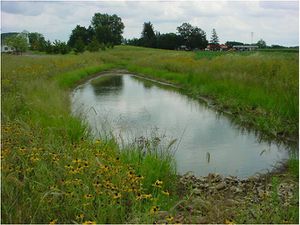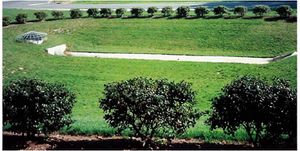
Types of stormwater ponds
Several distinct pond design variants (see CADD designs) are typically described in current stormwater management literature. While it is possible that any one of these pond types could be beneficially implemented somewhere in Minnesota, both the climatic conditions and the applicable regulations prevalent throughout the state strongly favor the use of one of them in particular, namely the wet extended detention pond (wet pond). Indeed, the wet pond is the only design variant fitting the description of a Wet Sedimentation Basin as described in the MPCA Construction General Permit (CGP). For this reason, much of this discussion focuses on wet extended detention ponds; however, all four main design variants are presented here for the sake of completeness.
Contents
Flow-through pond (no extended detention) design
Often called a “wet pond” in other literature, a pond that has an essentially unrestricted spillway as its primary outlet, with its crest at the elevation of the permanent pool. It provides water quality treatment by holding a volume of stormwater equal to the permanent pool volume, permitting settling to occur. The water stored in the pond is later displaced by new runoff. Note that “wet sedimentation basin” in the MPCA CGP is not a flow-through pond (“wet pond”) but rather a wet extended detention pond. The flow-through pond is generally not a good design option for Minnesota, because the storage volume allocated for treatment is entirely below the permanent pool, making it inaccessible to new runoff during frozen conditions (see Cold climate impact on runoff management).
Wet extended detention pond
The wet sedimentation basin referenced in the MPCA CGP falls under this category. This indicates a combination of permanent pool storage and extended detention storage above the permanent pool to provide additional water quality or rate control.
Micropool extended detention pond
This variation of the wet extended detention pond has a markedly smaller permanent pool at the pond outlet to prevent resuspension. Typically, the permanent pool in a micropool extended detention pond will not be large enough to satisfy the requirements of the MPCA CGP.
Dry pond
This pond has no permanent pool; it relies only upon extended detention storage for its treatment volume. It is highly susceptible to sediment resuspension and generally only useful for rate control.
Related pages
- Overview for stormwater ponds
- Types of stormwater ponds
- Design criteria for stormwater ponds
- Design considerations for constructed stormwater ponds used for harvest and irrigation use/reuse
- Construction specifications for stormwater ponds
- Assessing the performance of stormwater ponds
- Operation and maintenance of stormwater ponds
- Cost-benefit considerations for stormwater ponds
- Calculating credits for stormwater ponds
- Stormwater wet pond fact sheet
- References for stormwater ponds
- Requirements, recommendations and information for using stormwater pond as a BMP in the MIDS calculator
This page was last edited on 15 August 2022, at 21:02.



